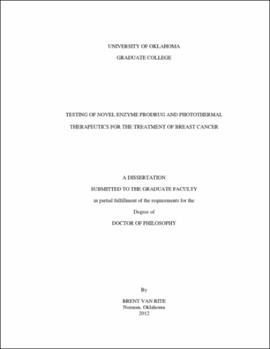| dc.contributor.advisor | Harrison, Roger G | |
| dc.creator | Van Rite, Brent D | |
| dc.date.accessioned | 2019-04-27T21:34:16Z | |
| dc.date.available | 2019-04-27T21:34:16Z | |
| dc.date.issued | 2012 | |
| dc.identifier | 99306811402042 | |
| dc.identifier.uri | https://hdl.handle.net/11244/319047 | |
| dc.description.abstract | The majority of this work characterizes two novel enzyme prodrug therapies using fusion proteins containing annexin V to target only tumor vascular endothelial cells and cancer cells, reducing the burden of systemic toxicity in healthy tissue. Methioninase enzyme will convert inert selenomethionine to toxic methylselenol and also deplete the cancer cells of methionine necessary for protein synthesis and continued growth. Cytosine deaminase converts 5-fluorocytosine into the well-known cancer therapeutic 5-fluorouracil. Additionally, continued work using single-walled carbon nanotubes targeted to cancer cells by the F3 peptide was done. | |
| dc.description.abstract | Recombinant technology was used to express and purify methioninase-annexin V and cytosine deaminase-annexin V fusion proteins. In vitro testing of binding and cytotoxicity were completed. Studies of both fusion proteins binding to human endothelial cells and two breast cancer cell lines were done to obtain dissociation constants in the range of 0.6-6 nM, indicating relatively strong binding. Cytotoxicity studies revealed that methioninase-annexin V with selenomethionine can kill those same cell lines in only 3 days; cytosine deaminase-annexin V accomplished the same goal in 9 days using 5-fluorocytosine. | |
| dc.description.abstract | The remaining enzyme prodrug work involved testing the methioninase-annexin V system in vivo. Pharmacokinetic testing revealed complete clearance of methioninase-annexin V from the bloodstream to occur within 8 hours following intraperitoneal injection. Selenomethionine levels up to 12 mg/kg were shown to cause no apparent toxicity, while higher levels were lethal. Tests were done with a maximum of 10 mg/kg. The enzyme prodrug system demonstrated a significant slowing of tumor growth compared to untreated mice or mice treated only with the prodrug or fusion protein. Using a fluorescent dye, it was shown that the blood flow through the treated tumor was significantly reduced. The results obtained in vivo with this enzyme prodrug treatment are promising. | |
| dc.description.abstract | F3-targeted single-walled carbon nanotubes were tested for their ability to bind to and become internalized by endothelial cells and breast cancer cells. Following incubation with SWNT-F3, cells were irradiated with a near-infrared laser 980 nm. The irradiation increased the cell death as determined by a cell viability assay. The photothermal therapy produced promising results in vitro, and tests with mice are recommended. | |
| dc.format.extent | 195 pages | |
| dc.format.medium | application.pdf | |
| dc.language | en_US | |
| dc.relation.requires | Adobe Acrobat Reader | |
| dc.subject | Breast--Cancer | |
| dc.subject | Tumors--Treatment | |
| dc.subject | Prodrugs | |
| dc.title | TESTING OF NOVEL ENZYME PRODRUG AND PHOTOTHERMAL THERAPEUTICS FOR THE TREATMENT OF BREAST CANCER | |
| dc.type | text | |
| dc.type | document | |
| dc.thesis.degree | Ph.D. | |
| ou.group | College of Engineering::Department of Engineering | |
